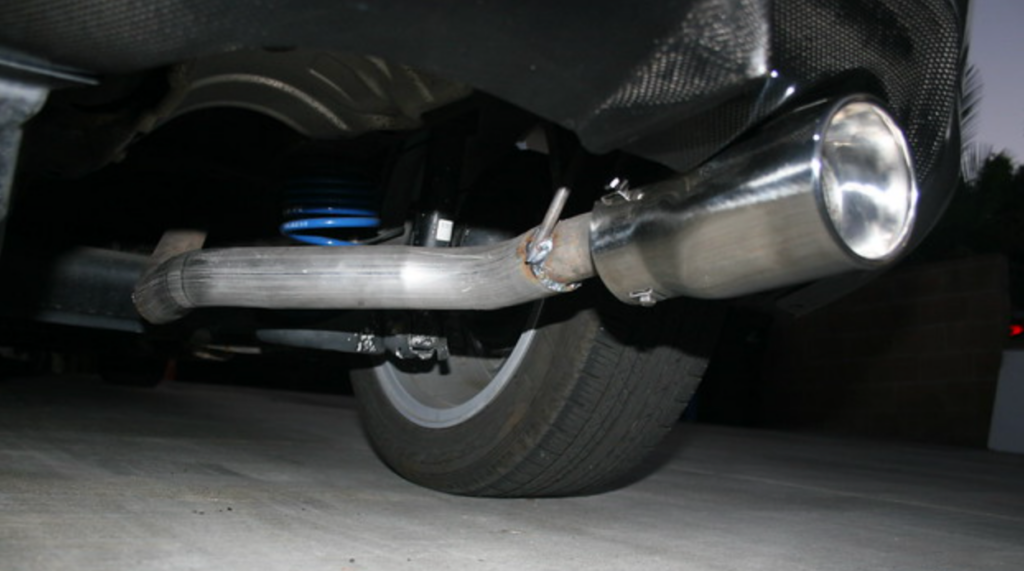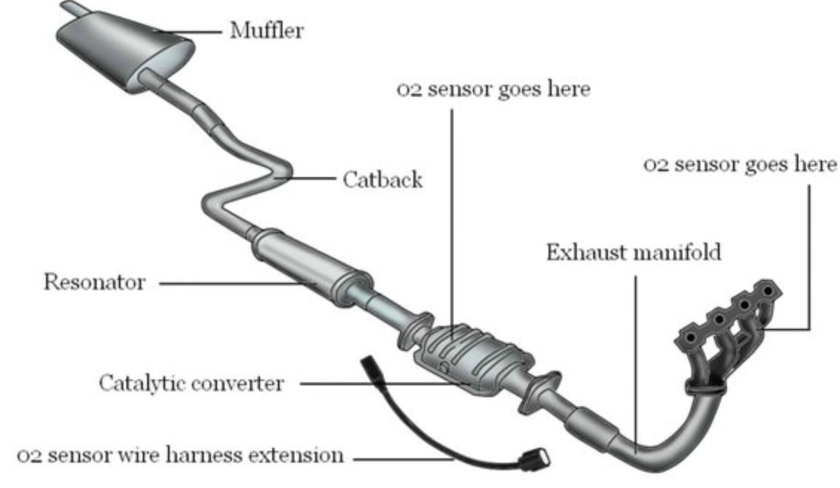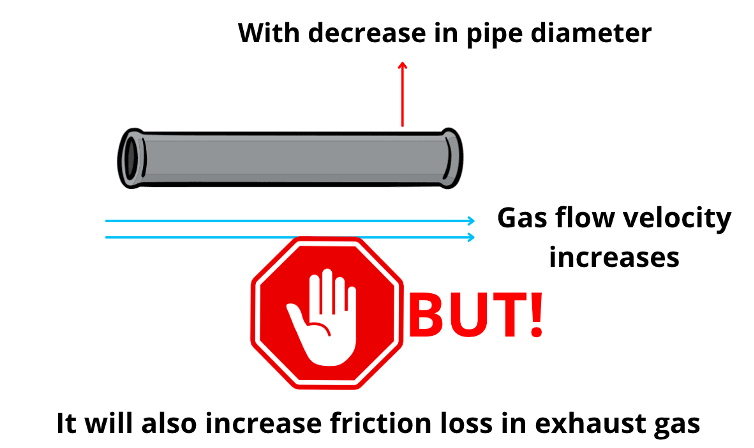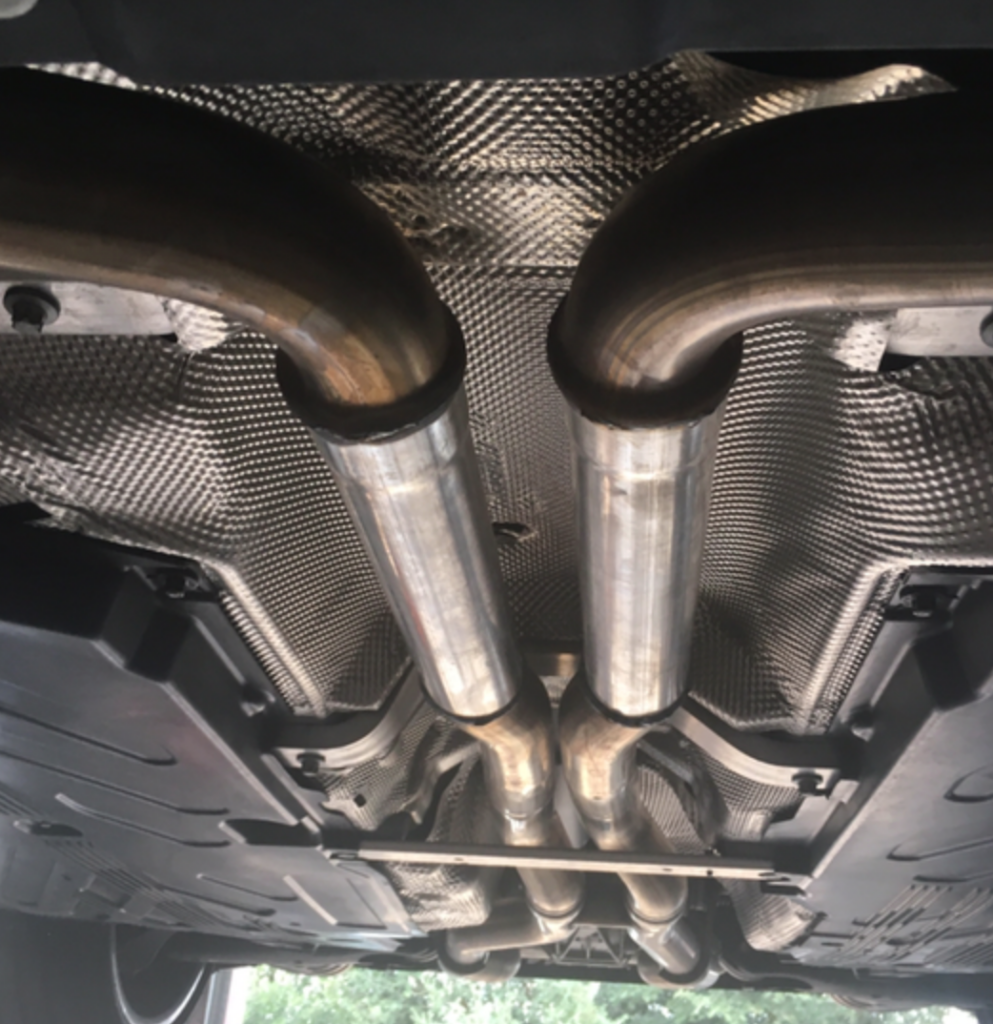Straight Pipe Exhaust System (Some Myths With Pros and Cons)
While so-called “straight pipes” directly connect the engine to the rear tailpipe, the gains are mostly noise, not performance. These no-muffler configurations do allow maximum airflow by eliminating backpressure. However, the horsepower boosts are minimal for most engines. What straight pipes lack in potency, they make up for in volume – often illegally so. Their deafening noise violates many local regulations on emissions controls. Simply put, straight pipes prioritize attention over real gains. They provide meager returns in power at the cost of noise pollution. This makes them unpopular everywhere except among those with more ego than engine.
Want a louder roar from your car? Taking off the muffler and catalytic converter can give you more horsepower and a growlier engine sound.
But straight pipes have downsides. Without parts to reduce noise, the inside of your car can get really loud. Also, straight pipes increase pollution from your car exhaust. And your car might fail emissions testing.
In this short guide, we share key details about straight pipes. That way you can decide if they are right for you.

Before exploring further about the straight pipe exhaust system, first, let me explain the concept of back pressure in the exhaust system of the engine. This is very important for you to understand this concept as back pressure is the reason people want to switch to the straight pipe exhaust system.
What Does Back Pressure Mean in Exhaust System?
Back pressure in exhaust system is a measure of resistance to the flow of exhaust gases when they flow through the pipes.
When the engine is running, the exhaust system sends the gas from the cylinders to the tailpipe.
The tailpipe is connected to the muffler. Back pressure is created by the catalytic converter, particulate filter( in diesel engines), bends in the pipe, muffler, and other components such as resonator through which exhaust emissions have to pass before passing through the tailpipe and entering the environment.
The higher the back pressure, the lower the flow of exhaust gas.
There are the following important components in the exhaust system of an engine:
- Catalytic converter
- Resonator
- Muffler
- Tailpipe
The catalytic converter is installed after the engine and is connected with the exhaust header/manifold. The muffler is a sound attenuator, and the tailpipe is the exhaust outlet.
Here’s how a typical exhaust system looks:

The purpose of a catalytic converter is to convert harmful emissions such as oxides of nitrogen and carbon monoxide to less harmful gases i.e. nitrogen and carbon dioxide.
On the other hand, the function of the muffler and resonator in the engine is to reduce the noise and frequency level of the sound waves. produced by the exhaust gases when they pass through the pipes at a pretty high speed.
Muffler basically reduces the volume of exhaust gases but does not change the sound. A resonator modifies the sound waves of the exhaust gases and reduces the unwanted resonance.
All those components I explained above act as restrictions to the flow of exhaust gases when they travel from the exhaust manifold to the tailpipe. In simple words, back pressure is simply fluid friction.
Whenever a fluid (exhaust gas in our case) passes through an area of a smaller crosssection or faces any restriction in its path, the fluid friction is increased which is the cause of back pressure.
For instance, when passing through a pipe, a fluid or a gas comes across a bend or a turn in the pipe, this will act as a restriction and oppose the fluid flow.
As an example, if there is a traffic jam at a signal, vehicles will find it hard to cross the road. The same is the case with the exhaust gases when they pass through the exhaust system.
So, in order to force the exhaust gases to pass through all those restrictions, the piston of the engine has to do more work against that back pressure.
So, there is more load on the engine’s crankshaft. Due to this reason, some people feel the need for a straight pipe exhaust system.
Back Pressure Is A Myth!
Now, some people believe that back pressure improves engine performance and efficiency. People confuse back pressure with the exhaust velocity of the gases.
For instance, if someone installs a 3” exhaust, he would wonder why his engine is losing power as he has tried to eliminate the back pressure (restriction to the fluid flow) by increasing the area. You will be wondering if a wider pipe allows more fluid and does not offer any resistance to the gas flow, then why a wider pipe isn’t better.
The constrictions in the gas flow increase its velocity (which is good for the fast removal of exhaust gases), but it also increases back pressure (which is bad for the gas flow). That’s why people often confuse the back pressure and the flow velocity.
Check out the below video for a better understanding.
Take an example of a garden hose w/o a spray nozzle. If you let the water just run unrestricted out of the hose, it flows at a rather slow rate.
However, if you put your finger on the part of the opening of the hose, the water will flow out at a much faster rate.
The smaller the area, the higher the velocity. So, the exhaust gases in the 2″ pipe will be traveling considerably faster than the exhaust gases in the 3″ pipe.

While selecting the right diameter of exhaust pipes, we need to balance the flow capacity of exhaust gases.
No doubt, velocity is increasing with the smaller area, but we are also putting the restriction in the direction of the gas flow, which is increasing the friction, or we can say this is the energy lost from the exhaust gases due to the friction. To overcome this friction, the power of the engine is lost.
Below, I have attached the snapshot of an equation I came across during my engineering studies while analyzing the effect of the diameter of a pipe on fluid friction.

In the above equation, ‘d’ is the pipe diameter, ‘hf’ is the friction in the fluid (back pressure) and ‘V’ is the velocity of the gas. Ignore the other factors for simple understanding.
Now, if ‘d’ decreases, ‘V’ increases. So, overall the friction in the exhaust gases will increase which will affect the horsepower of the engine.
Coming to the point, a smaller pipe diameter will produce higher exhaust gas velocities at a lower engine RPM but will create unacceptably high amounts of back pressure at high engine RPM.
Thus if your powerband is located at 2-3000 RPM, you would want a narrower pipe than if your powerband is located at 8-9000RPM.
Considering the above discussion, engineers try to keep the exhaust diameter wide enough so that there is as little backpressure as possible while maintaining suitable exhaust gas velocity.
By reducing the backpressure, exhaust gases can vacate the engine cylinder more rapidly – a phenomenon often referred to as the ‘scavenging effect‘.
However, a too wide pipe diameter will eliminate the resistance to the flow, but it will significantly reduce the velocity of exhaust gases, due to which the gases will stagnate in the pipe and create more resistance to getting the exhaust out the other end.
What Is A Straight Pipe Exhaust System?
A straight pipe exhaust system is a non-conventional exhaust system that consists of a straight stainless steel pipe that is connected with the exhaust header without a muffler, resonator, and catalytic converter.
So, after combustion, straight pipe exhaust systems let exhaust gases low freely from the engine’s exhaust headers, allowing them to go into the atmosphere directly through the exhaust outlet without passing through any equipment.
The straight pipe has a specific diameter to fit snugly into the engine’s exhaust manifold.
Car enthusiasts like straight pipe exhaust systems because of the sportier or roar sound and the enhanced horsepower as the components that restrict the exhaust gas flow are not present in the straight pipe exhaust system.
What Is The Difference Between Test Pipe and Straight Pipe?
A test pipe removes the catalytic converter, while a straight pipe removes all mufflers and resonators in addition to the catalytic converter. Both increase exhaust flow and sound, but a straight pipe is louder.
When it comes to raw power increases, straight pipes provide the biggest gains due to their completely unrestricted flow. Test pipes come next as they delete cats but leave mufflers in place.
In terms of sound characteristics, straight pipes produce an unpleasantly raspy and unrefined note because of their lack of muffling. Test pipes have a slightly melodic tone to them as mufflers still play a role.
Resonated test pipes take it a step further by having small expansion chambers installed to relieve raspiness.
Most experienced car owners agree the best balance is achieved through high-flow catalytic converters or resonated test pipes which improve flow noticeably without sacrificing refinement.
In terms of legality issues, both test pipes and straight pipes violate federal emission standards since they remove components responsible for controlling pollutants. While they can theoretically be run on race tracks or private property, driving them on public roads is illegal.
In states with stricter laws like California, they increase the chances of fines if inspected.
Catalytic converter and muffler deletion also void manufacturer warranties on factory exhaust parts. It’s always better to research local exhaust modification regulations before any work is performed.
Importance source: https://www.bimmerforums.com/forum/showthread.php?2325714-Test-Pipes-or-Full-Straight-Pipe
What Are Alternative Options?
For those aiming to squeeze modest gains without noise or legal issues, high-flow catalytic converters provide near test pipe levels of flow increase while retaining emissions compliance.
Quality cat-back or axle-back systems from reputable brands like Stillen or Invidia deliver throatier tones under acceleration without an excessive drone.
Headers represent another choice for bigger power alongside a legal cat-back setup.
Intakes can supplement exhaust mods nicely too for affordable overall improvements. The choices really depend on an owner’s priorities of performance versus noise versus legal/practical concerns for daily use.
How Does a Straight Pipe Exhaust Look Like?

Removing the mufflers to let the engine’s thunderous roar freely escape is the straightforward idea behind a straight pipe exhaust. But fabricating a clean, functional straight pipe system requires knowledge and skill.
The first crucial step after unbolting the stock mufflers is extending the pipes from the catalytic converters rearward to the exhaust tips. Custom steel or stainless steel tubing must bridge the gap, cut to length and bent as needed to snake around fuel tanks, suspension links, and other undercarriage components. Carefully match the tube diameter – typically 2 to 2.5 inches – to the original piping for optimized exhaust flow.
Achieving a straight and smooth exhaust run depends on meticulous test fitting and measurements. The replacement pipes must clear all obstacles as they travel under the car, without binding or sagging. Sturdy new hangers fabricated from steel support the weight of the new exhaust system.
How the pipes terminate dramatically alters the look of the straight pipe exhaust. Some retain the factory exhaust tips for a subtle appearance, while others upgrade to aggressively-styled 3.5-4 inch rolled stainless steel tailpipes.
Dual-walled baffled tips reduce noise levels and aiming the pipes downward disperses fumes away from the vehicle.
Advantages of Straight Pipe Exhaust System
Here are some advantages of a straight pipe exhaust system:
1. Increased Performance and Horsepower
Straight pipe exhaust systems are typically designed to maximize exhaust flow while minimizing back pressure by eliminating the catalytic converter, muffler, and resonator.
Since the back pressure is reduced in the straight pipe exhaust system, the crankshaft does not have to do work against any resistance.
Therefore, you’ll get more torque and power in the straight pipe exhaust system. Due to this reason, straight pipe exhaust systems are found in racing cars and high-performance vehicles.
You can also read my guide on does straight piping increase mpg.
2. Less Vehicle Weight
Since there isn’t any component like muffler and catalytic converter after exhaust header in straight pipe exhaust systems, the weight of a vehicle is significantly reduced in straight pipe exhaust systems.
Due to this, the throttling feels slightly more sensitive when your car has a straight pipe exhaust system.
One person just removed a catalytic converter from the exhaust system of his Subaru Legacy GT 2.5 Turbo, which resulted in the reduction of 50lbs of the weight of his vehicle.
Considering this, if you also remove the muffler and resonator from the exhaust system, you can reduce the weight of your vehicle by around 100lbs.
The weight of an engine is an important factor in racing cars. Racing cars have a very high power-to-weight ratio and low center of gravity.
Racing cars are built to achieve top speeds. Racing cars must be light and agile to accelerate quickly.
Racing cars are designed to be lightweight to improve acceleration and cornering speed. This makes them more responsive. The lighter the car, the faster they go.
3. Might Sound Cool on the Right Car
A straight pipe exhaust system, when installed on the right car, produces a cool sound that draws everyone’s attention within a 1/8 mile radius instantly with the push of a pedal.
In this way, a straight pipe exhaust system makes your car more fun to drive as the roaring sound of an engine with unrestricted exhaust flow seems exciting.
Disadvantages of Straight Pipe Exhaust System
Here are the disadvantages of a straight pipe exhaust system:
1. Terrible Sound of the Exhaust
On most engines, straight pipe exhaust systems produce a terrible sound from the exhaust that makes it a really bad sign for the car.
In the states of the US like California, the straight pipe exhaust system is illegal as it produces an insane sound with an awful drone in the middle of the car when you go for a long highway rides, and your car speed goes over 50 mph.
A good exhaust is a beautiful tone with just enough volume to hear that tone.
According to the experts, straight pipe engine does produce exciting sound, but it is not applicable to all engines.
Usually, a straight pipe exhaust system sounds amazing on v8 engines. In other engines, you can adopt a different approach, and many people are applying this to get high performance and better sound from their engine.
That is, instead of removing the muffler, replace the stock muffler with a more open-style muffler that offers less restriction on exhuast flow and also produces a better sound without causing a drone in the engine and irritating the people in your surroundings.
Magnaflow makes high-performance mufflers that produce a deep and powerful exhaust sound without allowing it to irritate people. You can check Magnaflow mufflers on amazon.
People call stock mufflers “suitcase mufflers”. It is a huge thing in the center of your exhaust system behind the rear axle.
2. Harmful To the Environment
Since there is no catalytic converter in a simple pipe exhaust system, it will not convert harmful exhaust gases that cause smog, acid rain, and global warming. Those unfiltered exhaust emissions will also smell bad which can cause several diseases.
3. Depreciation in Resale Value of Vehicle
No one wants to buy a vehicle that is altered with the aftermarket engine parts, especially those that are critical for the engine. Due to this reason, modifying your car with a straight pipe exhaust system will also reduce its resale value.
How Much Horsepower Can Be Increased in a Straight Pipe Exhaust System?
If your stock system was already free-flowing, a straight pipe may only net you 8-10 extra ponies. But if your OEM setup was bottlenecked and restrictive, you could gain a healthy 15 horsepower or more with a straight pipe upgrade.
Beyond going to a full straight pipe system, you can also unlock extra power with a less radical cat-back exhaust upgrade. This maintains the catalytic converter for emissions compliance but replaces the stock muffler and tailpipe with larger-diameter tubing. Going this route generally costs $400-1,000 but doesn’t deliver quite as much of a kick as a full straight pipe.
When you are ready to really uncork your ride’s potential, a complete straight pipe system opens up the most additional horsepower for your dollar. With this simple bolt-on upgrade costing as little as $100-300, that extra muscle won’t break the bank.
Will Upgrading To Straight Pipe Exhaust Trigger Error Codes?
Installing a straight pipe exhaust system by removing the catalytic converter and other emissions components can often trigger error codes and dashboard warning lights.
This is because the oxygen sensors and other sensors detect the change in emissions from removing pollution control components.
Common error codes triggered include P0420 for catalytic converter efficiency, P0135 and P0141 for oxygen sensor issues, and P0101 for mass air flow sensor issues.
Newer OBDII vehicles may go into “limp mode” which reduces performance. The check engine light will come on indicating problems detected.
Methods like using oxygen sensor spacers or simulator adapters can trick the sensors into thinking the catalytic converter is still present. A proper ECU tune is often required as well to disable monitoring of deleted components and turn off triggered codes.
Some First Hand Experiences Of Different Users Shared In Communities
Our team conducted research across various online communities, forums, and subreddits to gather user comments and opinions on “Straight piping exhaust”. Here’s what they say:
User 1:
Just straight-piped my ’08 Mustang GT. The sound is incredible, but be warned, it’s LOUD. I initially loved the roar, but it’s not ideal for long drives. However, the power gain feels noticeable. If you’re considering it, remember it’s not just about the sound; the performance change is significant too.
User 2:
I straight-piped my Honda Civic as a fun project. It was great at first, but for daily driving, it’s a bit impractical. The noise gets tiring, and I’ve had a couple of complaints from neighbors. Make sure you’re ready for the attention, not all of it good.
User 3:
My neighbor straight-piped his Dodge Challenger. It sounds cool, but it’s extremely loud early in the morning. If you’re living in a suburban area, think about how it’ll affect your neighbors. Not everyone appreciates the roar of a muscle car at 7 AM.
User 4:
I straight piped my Chevy Silverado as a DIY project. The result was surprisingly good, but welding was a challenge. Make sure you have the right tools or get a pro to do it.
